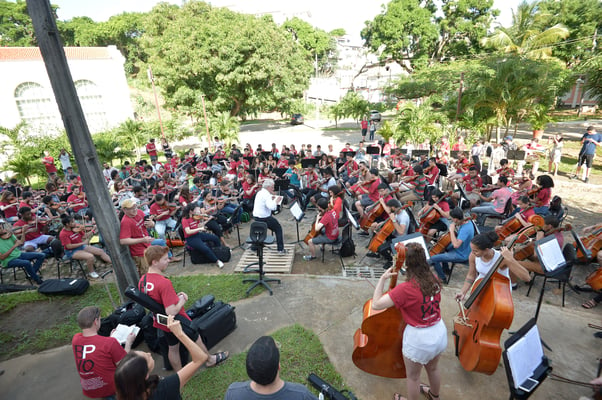
Boston Philharmonic Youth Orchestra 2019 Tour - Benjamin Zander's Highlights
How does one sum up the Boston Philharmonic Youth Orchestra’s eight-city, nine-concert tour of Brazil last month? If I told you it was “wonderful” and “extraordinary” it would scarcely tell the story, and yet, the trip – which stopped in the metropolises of Salvador, Rio de Janeiro, São Paulo, Ribeirão Preto, Campinas, Porto Alegre, Belo Horizonte, and Curitiba – was both.
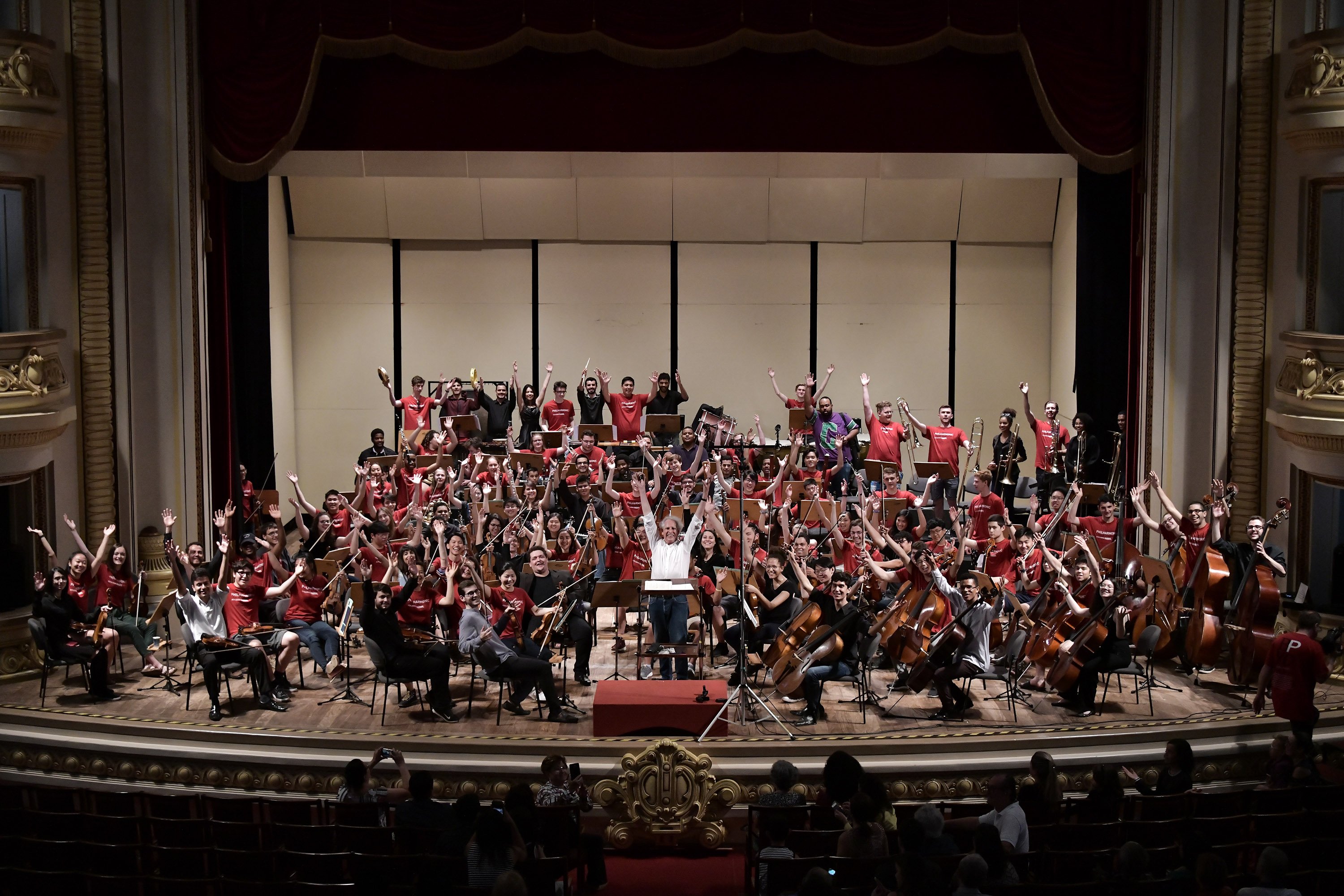
"How fascinating!": The BPYO with local musicians at an exchange in Ribeirão Preto's Theatro Pedro II
We drew the repertoire from the BPYO’s last season and anchored it with Rachmaninoff’s Piano Concerto no. 2 on all nine concerts (featuring the exceptional Anna Fedorova as soloist; more on her in a moment). Surrounding the Rachmaninoff (depending on the evening) came one of three curtain raisers – Wagner’s Act 1 Prelude to Die Meistersinger, Weber’s Euryanthe Overture, or Clarice Assad’s Bonecos de Olinda– and a symphony: either Shostakovich’s Tenth or Dvorak’s Ninth.
That’s meaty fare, to be sure. Any mix of those pieces demands deep reservoirs of concentration and stamina from any orchestra – not to mention a huge range of technical and expressive nuance.
But those are just the sorts of challenges on which the BPYO and I thrive. Our interpretations of these pieces developed from the first concert in Salvador to the last one in Curitiba. Certainly the orchestra started from a position of strength derived from the many months of rehearsals in Boston and the Symphony Hall performances. But to hear these readings deepen – in terms of flexibility, subtlety, and power – over the course of nine nights was, extremely gratifying.
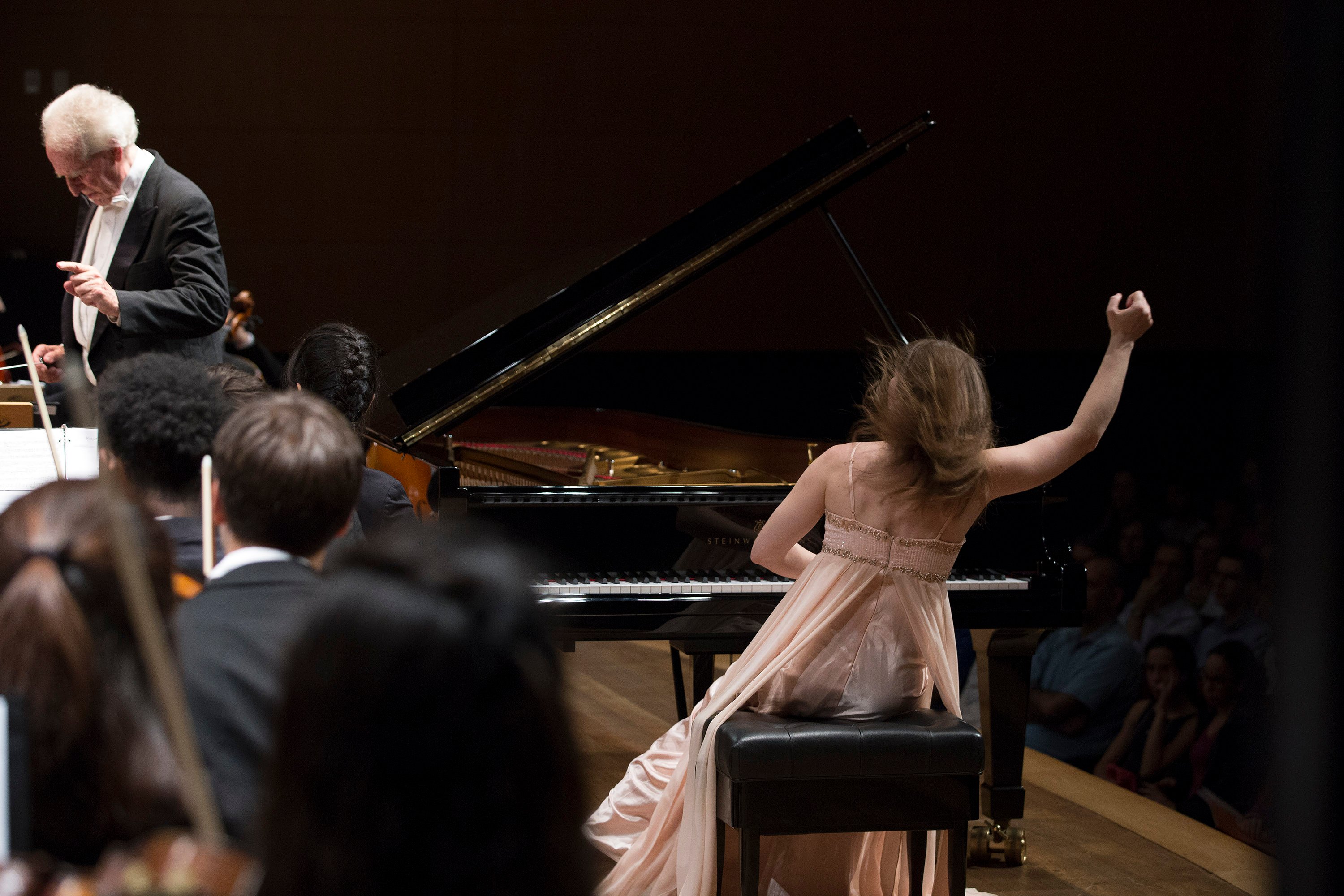
Anna Fedorova performing Rachmaninoff's Piano Concerto no. 2 in Belo Horizonte's Minas Tênis Clube
Anna Fedorova is a world-class pianist and the Rachmaninoff Second Concerto is her calling card (her YouTube performance from the Concertgebouw has been seen by a record-breaking 23 million people!). An artist of stupendous technical gifts and profound musical sensibilities, it was simply a delight to collaborate with her day after day and to watch the profound rapport she developed with the orchestra. Every night featured passionate, responsive, galvanic playing. Many people have told me that the Fedorova-BPYO Rachmaninoff rose to a benchmark.
Listen to the final tour performance of the Rachmaninoff here
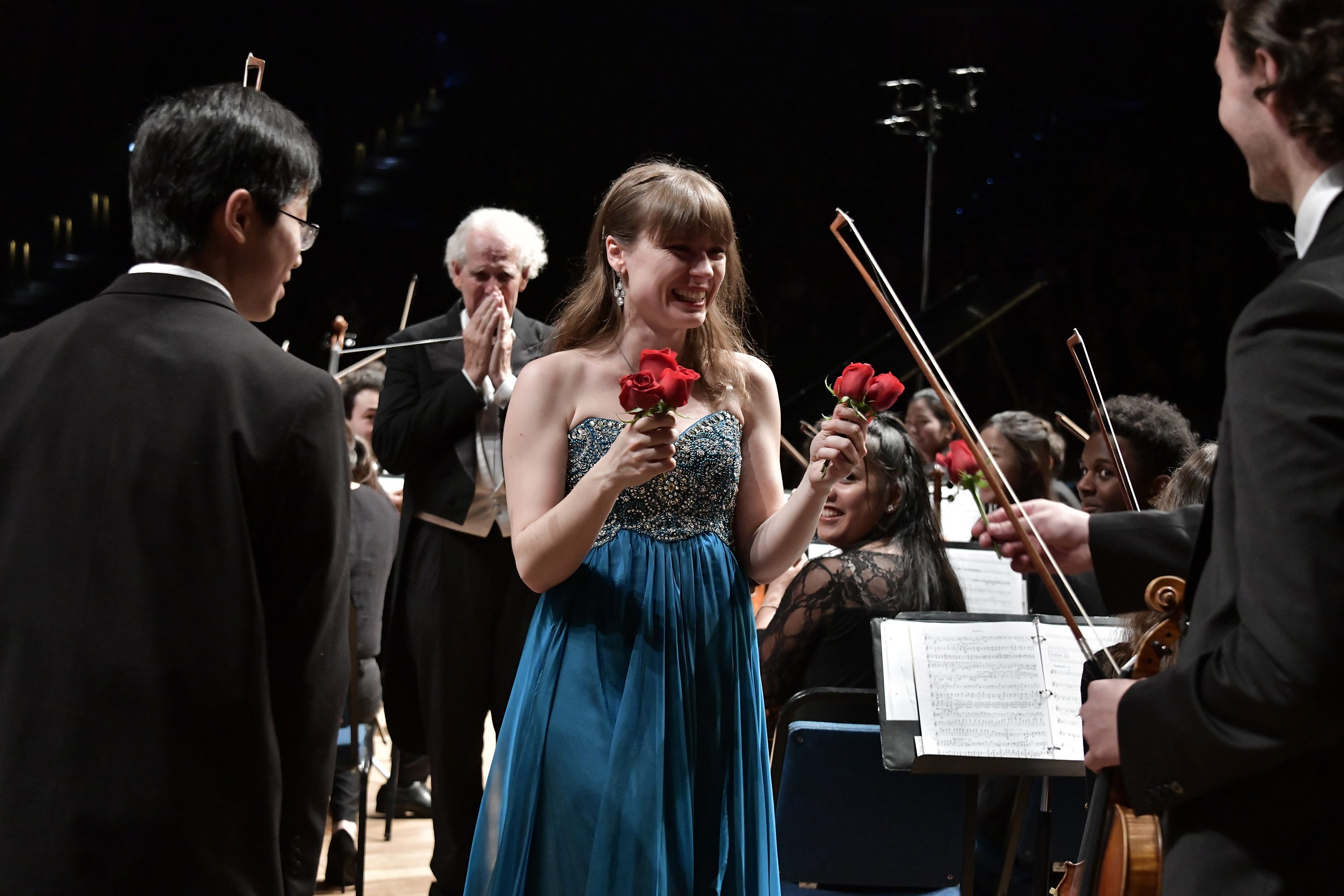
Fedorova receiving roses from BPYO violinists following her last Rach Two with the BPYO in Curitiba's Teatro Positivo
Brilliant musician though she is, Fedorova’s the anti-diva: totally approachable, down-to-earth, and unpretentious in person. Indeed, on tour, if she wasn’t practicing or giving masterclasses, she was hanging out with us in hotel lobbies, chatting with kids on the bus rides from city to city, joining us for meals. Anna was an utter delight to conduct and to be around.
In its seventh year, the BPYO is a youth orchestra in name only. Yes, it’s made up of players aged, 12 to 21 (the Brazil tour included several alumni to replace members who couldn’t go on the tour). But, aside from that, all that’s discernably “youthful” about the playing is the all-out emotional commitment of every single player.
“This is as refined and polished an orchestra as they come, on par with most professional outfits” wrote Jonathan Blumhofer, chief music critic for The Boston Classical Review and our accompanying tour diarist – an opinion that was nicely emphasized near the end of our trip when Boston Magazine named the BYPO the “Best Classical Ensemble” in Boston for 2019. They certainly played like it, venue after Brazilian venue.

The BPYO performing Shostakovich's Symphony no. 10 in the Sala São Paulo
And we got to perform in remarkable sites. Several were truly immaculate, like the aesthetic and acoustic gem that is the Sala São Paulo, or the Opera Garnier-inspired Theatro Municipal in Rio. Others, like Porto Alegre’s Auditório Araújo Vianna, a brick-and-concrete barn, left something to be desired, sound-wise. Read Jonathan Blumhofer's review of the Sala São Paulo concert here.
Regardless of where we were, though, fire and passion were our watchwords. The São Paulo concert, the tour’s third, was on a level that truly fit the quality of that incredible space. But two of our finest nights came in less-starry settings.
One was in Campinas’s Teatro Castro Mendes. The hall, itself, seats around 1000 and its folding seats recall a high school auditorium; the exterior blends into the urban jungle that is Campinas. That night, though, for a deeply-attentive and sold-out house, our performances of Wagner, Rachmaninoff, and Dvorak spoke with particularly electrifying force.

The interior of Porto Alegre's Auditório Araújo Vianna
On the next night in Porto Alegre we delivered a mixed but interesting concert. The Auditório Araújo Vianna, a massive complex that seats 3000 and caters primarily to rock and pop acts, had to be amplified for the BPYO and Fedorova. And, while the sound engineers managed a respectable balance among everybody on the stage, the orchestra’s and piano’s resonances still sounded somewhat unnatural.
But that night’s performance was something quite remarkable. Literally every music stand had a microphone above it, so there was nowhere for anybody to hide. As a result, according to Jonathan Blumhofer, all sorts of little details in the music — especially accompanimental lines in the Rachmaninoff — suddenly came to the fore, What’s more he told me that the amplification revealed an orchestra not only playing extremely well technically, but also one that was clearly listening to itself, its articulations and phrasings consistently matched and seamlessly passed off section to section.
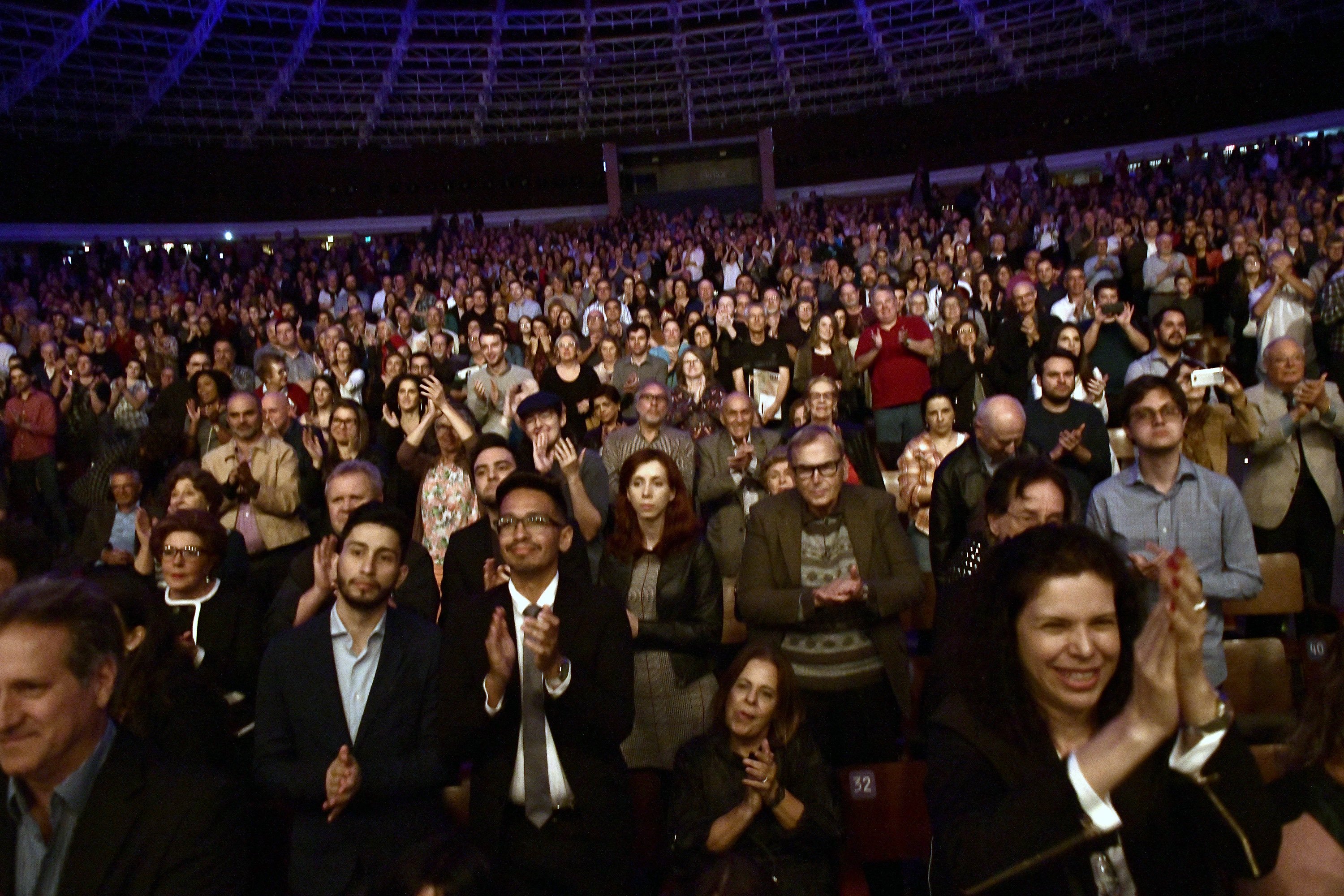
Some of the BPYO's audience in Porto Alegre
Blumhofer also reported that the audience in Porto Alegre (which filled about three-quarters of the cavernous hall) was among the most focused, appreciative, and best-behaved he had ever witnessed. They were completely caught up in the night’s performance: During the most rapt moments in the Rachmaninoff and Dvorak, we may as well have been in Bayreuth, so focused was their concentration. Indeed, we fed off of the palpable energy that night’s crowd transmitted to us – and it massively invigorated us.
Of course, formal concerts were only part of what the BPYO did in Brazil. A series of conducting masterclasses and side-by-side exchanges with local conductors and musicians from most of the cities we visited gave us satisfying encounters with Brazilian musicians and left some of the tour’s most lasting impressions.
A side-by-side with an El Sistema-inspired music school in Porto Alegre — located deep in a favela that required us to have an armed police escort there and back — was the tour’s most touching and, given the social, economic, and musical obstacles the kids there faced, heartbreaking.
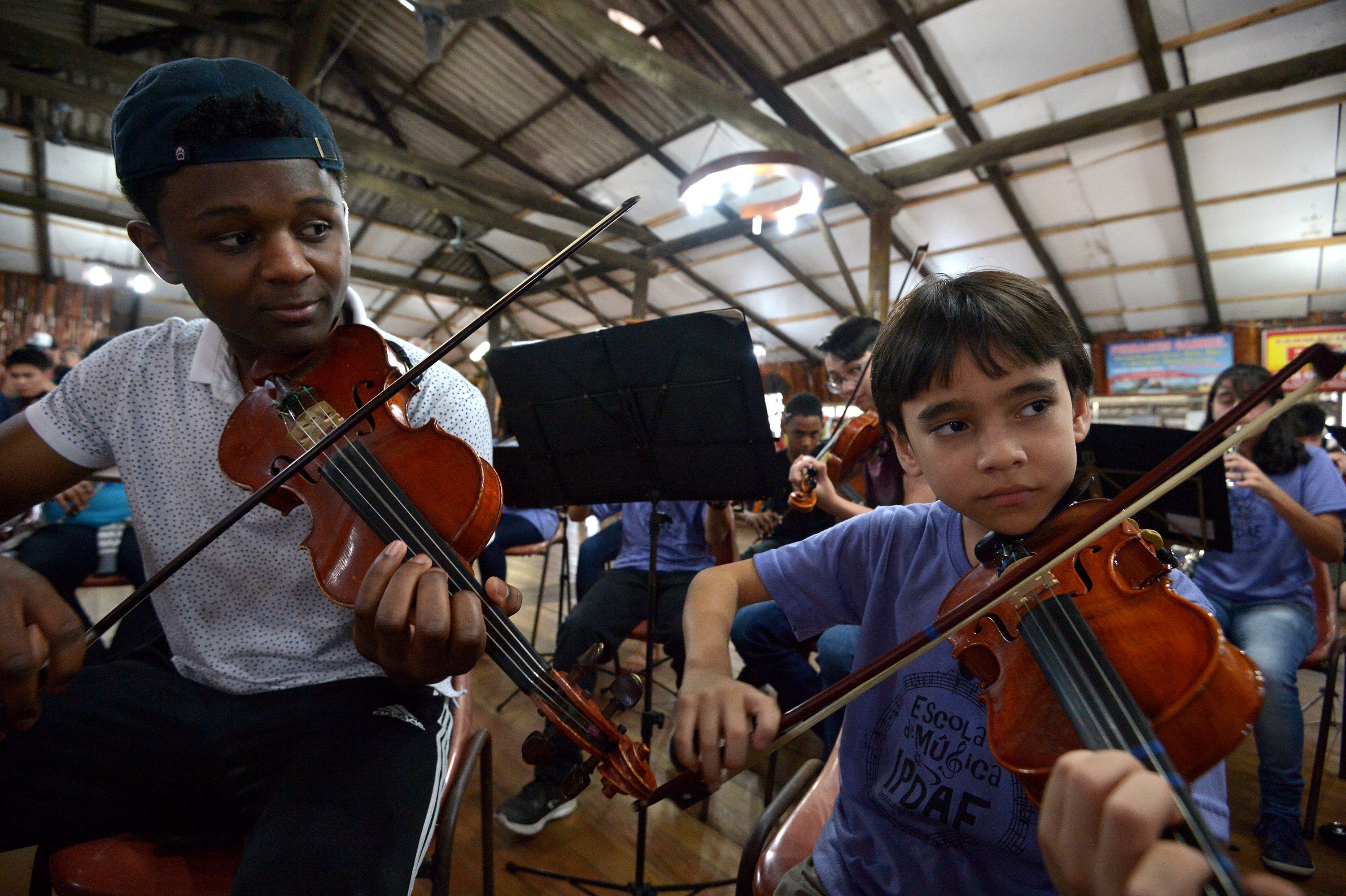
BPYO violinist Kerby Roberson with an eight-year-old colleague in Porto Alegre
In our first exchange, with Salvador’s NEOJIBA orchestra, pure joy abounded: the massive forces (which included nine oboes and ten bassoons) gave thrilling run-throughs of the New World Symphony’s finale and Tchaikovsky’s Romeo & Juliet Overture, al fresco, with apartment buildings rising above the compound walls and car horns blaring in the streets just a few feet away.
An exchange in São Paulo featured a group of five- through maybe seven-year-old children getting chances to conduct The Stars & Stripes Forever (I got my tour workout lifting them up one at a time!) and ended with more than a few BPYO members trekking out into the neighborhood with their new-found colleagues to indulge in the glories of Brazilian chicken.
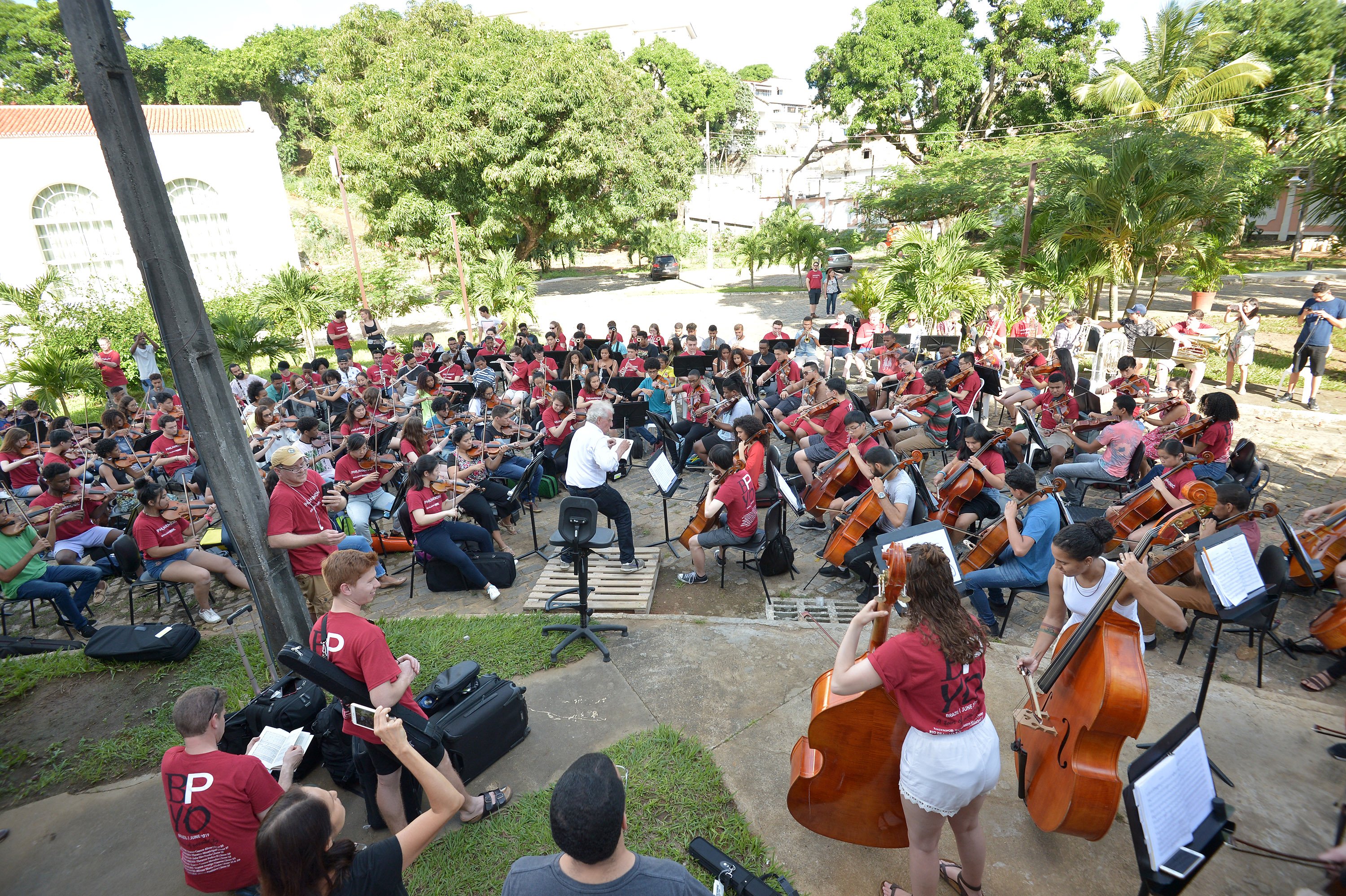
The BPYO playing Dvorak with NEOJIBA orchestra in Salvador
It’s perhaps ironic, but we had precious little time to do many touristy things in Brazil. A ride up Rio’s Sugar Loaf Mountain and a day trip to the colonial city of Ouro Preto were the trip’s main excursions, though Andrew Lan (our tour doctor) and a few cohorts managed to fit in some extra exploring in each place we visited, including Belo Horizonte’s incredible Mercado Central.
Still, we had a lovely introduction to the country and its people through our concerts and exchanges; our bus rides to Ribeirão Preto, Campinas, and Ouro Preto; the phenomenal cuisine we sampled everywhere we went; and the many folks who did their utmost to ensure that we enjoyed our visit. Culturally, musically, gastronomically — the BPYO’s tour gave us an unforgettable experience.

BPYO oboist Thomas Juhasz at a side-by-side exchange in São Paulo
But it also ran deeper than that. And perhaps I should yield my pen to Blumhofer.
He wrote in the last of eight blogs entries during the tour (you can find all of them here):
“That was the BPYO’s 2019 tour to Brazil. In just over two weeks the orchestra traversed more than 14,000 miles and played nine concerts in eight cities. By my estimate, the total audiences for those concerts numbered around 11,000 (not including those who came to the exchanges and open rehearsals). And, in our six side-by-side exchanges, we played with and for many hundreds moreBrazilian musicians.
“What conclusions – if any – can one draw from it?
“I’ve already talked about the massive enthusiasm we encountered from our Brazilian audiences. How that continued throughout the tour is something that will stick with me for a long time to come.
“There are no two ways around the fact that there’s a native curiosity about music in Brazil. As a result, we drew impressively-sized and engaged crowds to our concerts in every city we visited. While there is some sort of classical music network in Brazil, I’m still unsure of its extent and reach. Indeed, there were more than a few times when we’d hear that our concert was the first time someone (or several people) in our audience had heard an orchestra live – or classical music, for that matter (such was the case with one of our bus drivers in Rio, who came to our concert there).
“That said, our audiences were decidedly mixed, age-wise. I’d say at least a third to one-half of our hearers in each city looked to be aged forty and under – and there were usually a good number of children present, too. It was so refreshing to see so many young concert-goers. For all the not-unfounded concern about the state of the arts and music education in the U.S., there are a few things, I think, we can learn about general musical interest from our brothers and sisters in Brazil.
“As far as the BPYO goes, I came away from this trip as deeply impressed with them as ever. As a musical entity, they’re one of the elite ensembles in the country…
“But as a social experiment they’re even more remarkable. What Benjamin Zander is endeavoring to do with the BPYO is to create a generation of leaders by engaging these young musicians as artists as well as enrolling them in his personal philosophy of “possibility” – namely, enabling them to take creative advantage of whatever situation in which they find themselves (musical, professional, personal) to positively affect those around them.
“Teaching the selflessness and awareness this process requires is a tall task and sometimes a daunting one. But to see the musicians of the BPYO in action in Brazil – how willingly and instinctively they engaged with their cohorts at the exchanges, or how gamely and flexibly they went along with last-minute changes to the tour itinerary – was as refreshing as it was heartening. Surely, observing and spending time with members of this young generation, as Zander said several times during the tour, is enough to give one hope for the future.
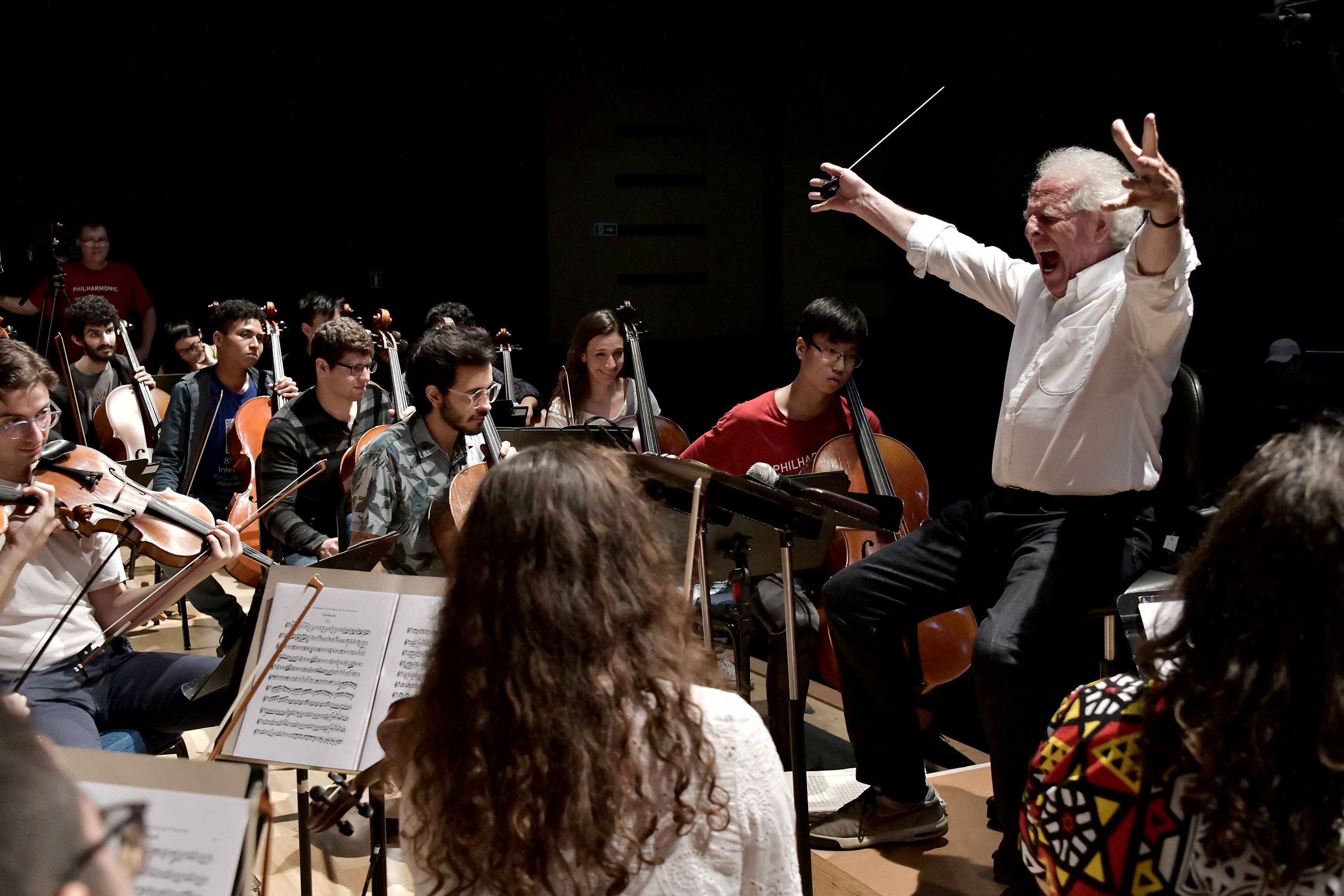
Benjamin Zander leading the tour's last exchange in Curitiba
“‘Where are the shining eyes?’ is a recurring Zander refrain and we heard it more than a few times these last two weeks. What are those eyes? They’re ones that radiate enthusiasm, wonder, and enrollment in the task at hand.
“The fact is, we saw a lot of shining eyes in Brazil.
“They were in the audiences who came to our concerts, responded with thunderous ovations, and then thronged to meet Zander and the orchestra after performances. They were there in the locals we met outside of concerts, as well: the shop owners, hotel workers, waiters, bus drivers, and others who went out of their way to make us feel welcome and at home in their beautiful country.
“We saw them, too, in the musicians we met during the side-by-side exchanges, from NEOJIBA and São Paulo to Ribeirão Preto and, especially, Porto Alegre. I’ll not soon forget the little girl I saw in that last city watching Kai Rocke, one of our bassoonists, toss off, by ear, the Brahms Hungarian Dance no. 5: her eyes were all but popping out of her head!
“The children who populated our open rehearsals (and, occasionally, side-by-sides) were similarly taken: from the kids who got to “conduct” The Stars & Stripes Forever to the little boy sitting on his mom’s lap, clapping along – perfectly in time – to that march in Ribeirão Preto.
“And you couldn’t miss the shining eyes in the BPYO. Like Paul Mardy’s, after he knocked off the dazzling clarinet runs in the last movement of the Shostakovich. Or Mark Macha’s while he was giving an impromptu trumpet lesson in Porto Alegre. Or Thomas Juhasz’s whenever he had his oboe in his hands. Or Luis Celis’ when he was playing The Stars & Stripes Forever or showing off his bass to the curious kids who clamored onstage after an exchange or…well, let’s face it: Luis’ eyes are shining pretty much constantly.
“Maybe Anna Fedorova put it best. In a note to Zander after our last concert, she wrote that, on this tour ‘I felt so loved, taken care of, surrounded by so much warmth…nothing would be able to top this experience! Sharing [the] stage with you almost every day was [the] greatest privilege and joy…I can say that experience of us playing together I can’t compare with anything else – it was just pure happiness every moment!’
“So it was.”
****************
After the tour in a final summing up piece Jonathan Blumhofer expanded on his impressions and included some of the white sheets from members of the orchestra:
“What Zander is endeavoring to do with the BPYO is to “create a generation of leaders by engaging these young musicians as artists as well as enrolling them in his personal philosophy of ‘possibility’ – namely, enabling them to take creative advantage of whatever situation in which they find themselves (musical, professional, personal) to positively affect those around them.”
It’s a tall order, yes, and nobody’s perfect: I can’t count the number of times I heard the terms “on-track” (good) and “off-track” (deviating from “on-track”) over those two weeks, and we did have a meeting in São Paulo to address some “off-track” behavior early on.
But to see how the players responded to Zander’s guidance (musical and otherwise) as well as the direction of BPYO manager Elisabeth Christensen and the quiet-but-steady leadership of BPYO senior advisor Mark Churchill – adapting to last-minute changes in the itinerary, taking ownership of various aspects of the tour, and the like – was (as I wrote in the above-mentioned blog post) “refreshing as it was heartening.” To be sure, there are many ensembles (and youth orchestras) in our world. But, without a doubt, the culture of leadership and responsibility that permeates the BPYO is singular.
The kids who comprise the ensemble certainly are. I got to chat in-depth with a fraction of them, but what a brilliant, thoughtful, articulate, engaged, and talented lot they are. You get a sense of that from the white sheets Zander asks them to fill out after each rehearsal and at the end of every tour: blank sheets of paper on which orchestra members can freely speak their minds.
A sampling of their end-of-tour reminiscences is in order.
“One particular thing that surprised me,” bassist Evan Tsai wrote in his, “was how the side-by-side exchanges would directly affect me. I had become so accustomed to playing music in a little ‘bubble’ (at school and in Boston) that I took the little things – what everyone considers ‘necessary’ to become a musician – for granted.
“Yet, after seeing Quinn’s [BPYO trombonist Quinn McGillis’s] generosity in donating a trumpet and trombone to the school in Porto Allegra [sic] and playing alongside those kids, I realized that there were still kids with a desire to learn music and kids that love music already without the proper resources to fulfill that passion. Those few hours spent at that school inspired…me to…ensure that …future generations of musicians and leaders(!) have access to instruments and musical training. Although they ultimately might not choose music as a career path, being exposed to music shows them how to love, communicate, as well as teaches them discipline, respect, perseverance, and a good work ethic.”
Cellist Jonah Covell noted the transformative aspect of touring with the orchestra in his white sheet: “Throughout the year we [the cello section] played together, and that was about it. We could sound good, sometimes excellent, we could blend our tones, we could come in on time, we could lead and follow one another, and we usually played in tune…
“But our experiences in Brazil changed something in our section’s coding…somewhere between Logan Airport on the 13thand Rio De Janeiro on the 17th, our section became a community. We were no longer a group of musicians, but we were now a unit as cohesive as can be. We supported each other on and offstage, we joked around together (admittedly, sometimes onstage), ate together and did a million other things as a group. We were no longer just a section in an Orchestra dedicated to playing well. We were a family driven to create a singular sound that expressed the souls and spirits of each of our members. In our sound was our love for each other; for the people we’d met; the places we’d taken in; and, above all, for the experience of making music with those we really love.”
And some touched on the BPYO’s larger place in the musical firmament.
“What distinguishes the BPYO from any other orchestra in the world,” violinist Simeon Radev observed, “is that we have a mission. We’re not just making music, but we’re making music with a purpose, and that purpose is to share our joy and hope and love with the rest of the world. Our message is so powerful, that we cause people like William to fly to São Paulo right after he hears our concert in Rio, or we have a lady nearing 100 years of age, in Ribeirão Preto, who says that if she dies today she will be happy because she has heard our music, or a person like Peterson in Curitiba, who was brought back from a path of disillusionment with music, to a path filled with light and hope through music, all because he heard our final, and most emotional, concert…
“I do not know of any orchestras, organizations, or people in general who can cross language barriers and all sorts of other difficulties in order to touch the hearts of a completely different people and cause such profound reactions in their lives. Of course, I am still quite young and have not seen much of the world and have not lived enough life to say that with certainty. But I am confident that you would not do what you do for each and every single one of us if you did not believe that what we do here is totally unique and powerful.”
There are scores more like these. Seen in that light, then, labeling the BPYO’s Brazilian tour “wonderful” and “extraordinary” seems only a starting point.
Perhaps the final word belongs to the indefatigable Zander, whose energy and enthusiasm for spreading the Gospel of classical music and Possibility knows no bounds. Looking back on the tour, he wrote:
“The energy level didn’t drop, ever. Why give less at the end of the tour, on the final afternoon, when everyone is exhausted? Dvorak needs all from all of us. Age is no barrier to generosity – young or old!
“The camaraderie and open-heartedness spreads out to everyone through the group and beyond. One-hundred-eighty kids outside on a courtyard reliving young love and death under the sun. Why pull back?
“The performances got better and better, even though there was no time to practice, because enthusiasm penetrates the group's psyche.
“There are no ‘bad apples’ only people ‘on track’ and ‘off-track.’ Mistakes can bring people closer, instead of dividing them. Hence the meetings. You never give up on kids!
“Music is an irresistible force that unites those that play and those that only watch and listen. The audiences reacted in the way they did from relief and joy when they realized everyone is connected. That used to be the province of religion, now it’s a youth orchestra on tour!”
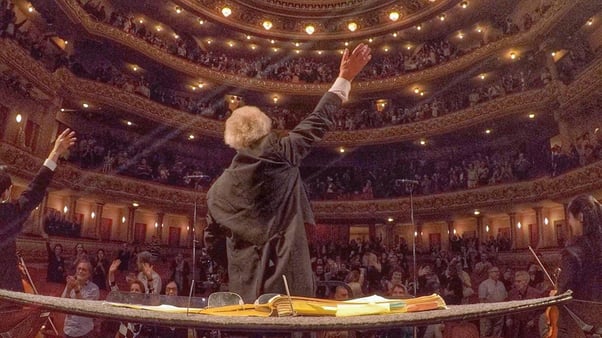
Final bows (and waves) in Rio de Janeiro's Theatro Municipal
Photos by: Paul Marotta and Paul Mardy
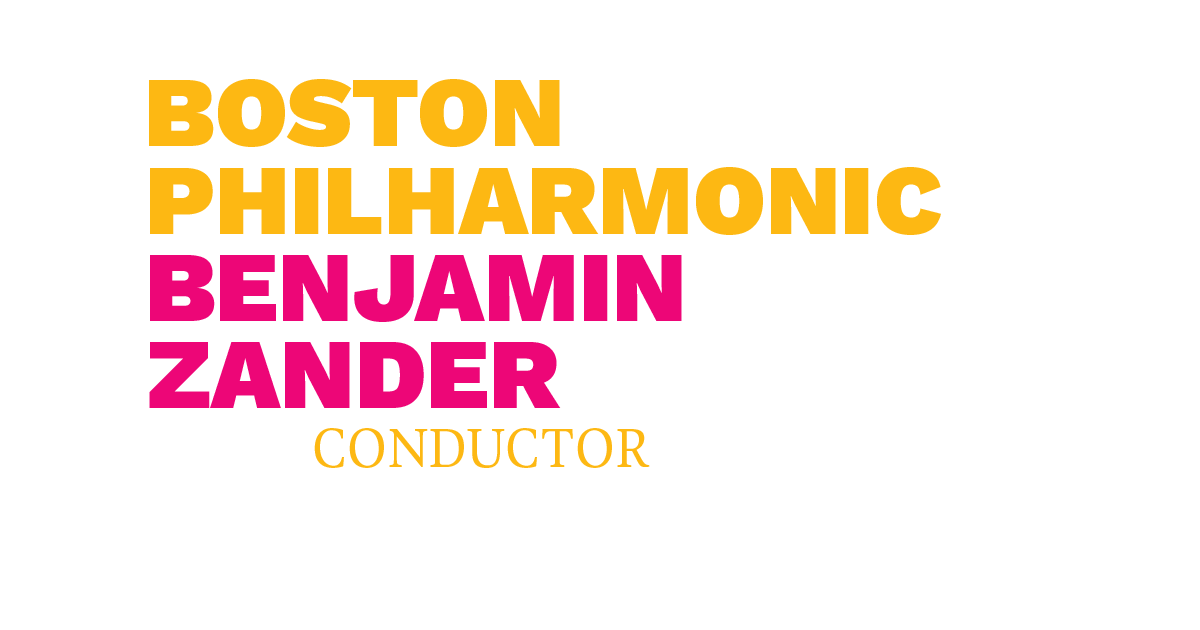
.jpeg?width=100&height=100&name=Zander%20Headshot%20(Email).jpeg)



